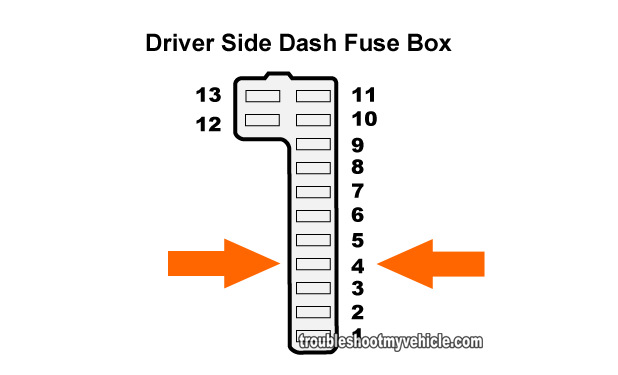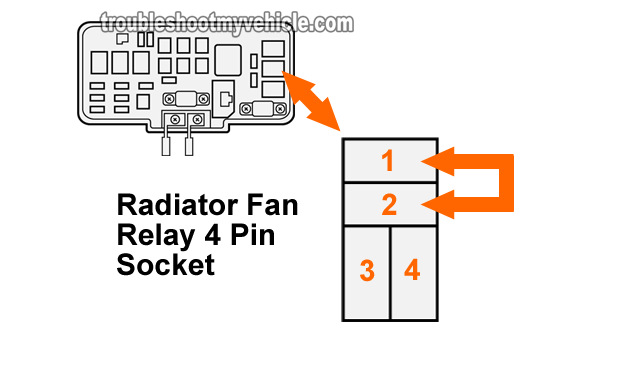TEST 1: Checking The Radiator Fan Relay Power Circuits


The first order of business is to see if the radiator fan relay is getting power on circuits 1 and 3.
Circuit 1 is the one that gets power from fuse #57 (20 Amp) in the under-hood fuse box. Fuse #57 is the radiator fan motor's power source, once the fan relay is activated of course (see photo 3 of 4).
Circuit 3 gets power from fuse #4 (7.5 Amp) of the driver side under-dash fuse box. Fuse #4 provides power for the relay's coil and is one part of the relay's control circuit (the other part is the radiator fan switch) (see photo 4 of 4).
NOTE: The above fan motor relay fuse numbers are for the 1998 to 2001 Honda Accord. If your vehicle is not an Accord, the fuse number and its location may be different.
OK, this is what you need to do:
- 1
Remove the radiator fan relay from its place on the under-hood fuse box.
NOTE: You'll be making your multimeter test connections on the female terminals of the now empty relay socket of the radiator fan relay AND NOT on the relay itself. - 2
Check female terminal labeled #1 for 12 Volts.
Place your multimeter in Volts mode. Touch the red multimeter test lead to circuit #1 of radiator fan relay socket's female terminal. Black test lead to Ground (see the photo 1 of 4 in the image viewer). - 3
Turn the key to the ON position and check female terminal labeled #3 for 12 Volts.
Place your multimeter in Volts mode. Touch the red multimeter test lead to circuit #3 female terminal. Black test lead to Ground. - 4
Your multimeter should register 12 Volts for both parts of this test.
Remember: Female terminal #1, of the radiator fan relay socket, is hot all of the time. Female terminal #3 has power only with the KOEO and KOER.
Let's take a look at what your test results mean:
CASE 1: The multimeter registered 12 Volts for both circuits. So far so good, since this is the correct and expected test result.
This test result tells you 2 specific things:
- That fuse #57 (20 Amp) in the under-hood fuse box is good and supplying power.
- That fuse #4 (7.5 Amp) in the driver side dash fuse box is good and supplying power.
The next step is to jumper terminals #1 and #2 of the radiator fan relay socket. For this test, go to: TEST 2: Bypassing The Radiator Fan Relay.
CASE 2: The multimeter DID NOT register 12 Volts for circuit #1. Recheck your multimeter settings and connections and retest.
If you still don't get 12 Volts, then this usually means that fuse #57, in the under-hood fuse box, is blown.
Check the fuse and replace if necessary. If the fuse is blown, this is usually due to the fact that the radiator fan motor is bad. To test the radiator fan motor itself, see this tutorial: How To Test The Radiator Fan Motor (Honda 2.2L, 2.3L).
CASE 3: The multimeter DID NOT register 12 Volts for circuit #3. Recheck your multimeter settings and connections and retest.
If you still don't get 12 Volts, then this usually means that fuse #4, of the driver side fuse box, is blown. Check the fuse and replace if necessary and retest.
TEST 2: Bypassing The Radiator Fan Relay


After confirming that female terminal #1 (of the radiator relay socket) is being fed with 12 Volt, the next step is to use a jumper wire and jumper together female terminal #1 and #2 of the radiator relay socket.
This test will, indirectly, tell us if the radiator fan relay is bad.
IMPORTANT: Be careful not to damage the female terminals with your jumper wire. If you open them up permanently, with the jumper wire, you'll need to replace the entire fuse box.
Alright, this is what you need to do:
- 1
Jumper female terminals #1 and #2 of the radiator fan relay socket (of the under-hood fuse box).
- 2
The radiator fan motor should come on, as soon as the two terminals are jumpered together.
- 3
Remove the jumper wire once you've confirmed that the radiator fan has or has not come on.
Let's take a look at your test results:
CASE 1: The radiator fan came on. This is the correct and expected test result. This test result confirms the following important things:
- The circuits between the radiator fan motor and the radiator fan relay socket (#1 and #2) are OK (otherwise the radiator fan motor would not have come on).
- The radiator fan motor is good.
The next step is test the radiator fan switch. Go to: TEST 4: Bypassing The Radiator Fan Switch.
CASE 2: The radiator fan DID NOT come on. Double check all of your test connections and make sure that the radiator fan motor is connected to its connector and repeat the test.
If the radiator fan motor still doesn't activate and in TEST 1 terminal #1 of the relay socket has power, then the radiator is bad and needs to be replaced.
Now, if I where in your shoes, and if I hadn't already, I would test the radiator fan motor directly by applying power and Ground to it manually. I've written a tutorial for this particular test and you can find it here: How To Test The Radiator Fan Motor (Honda 2.2L, 2.3L).






